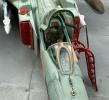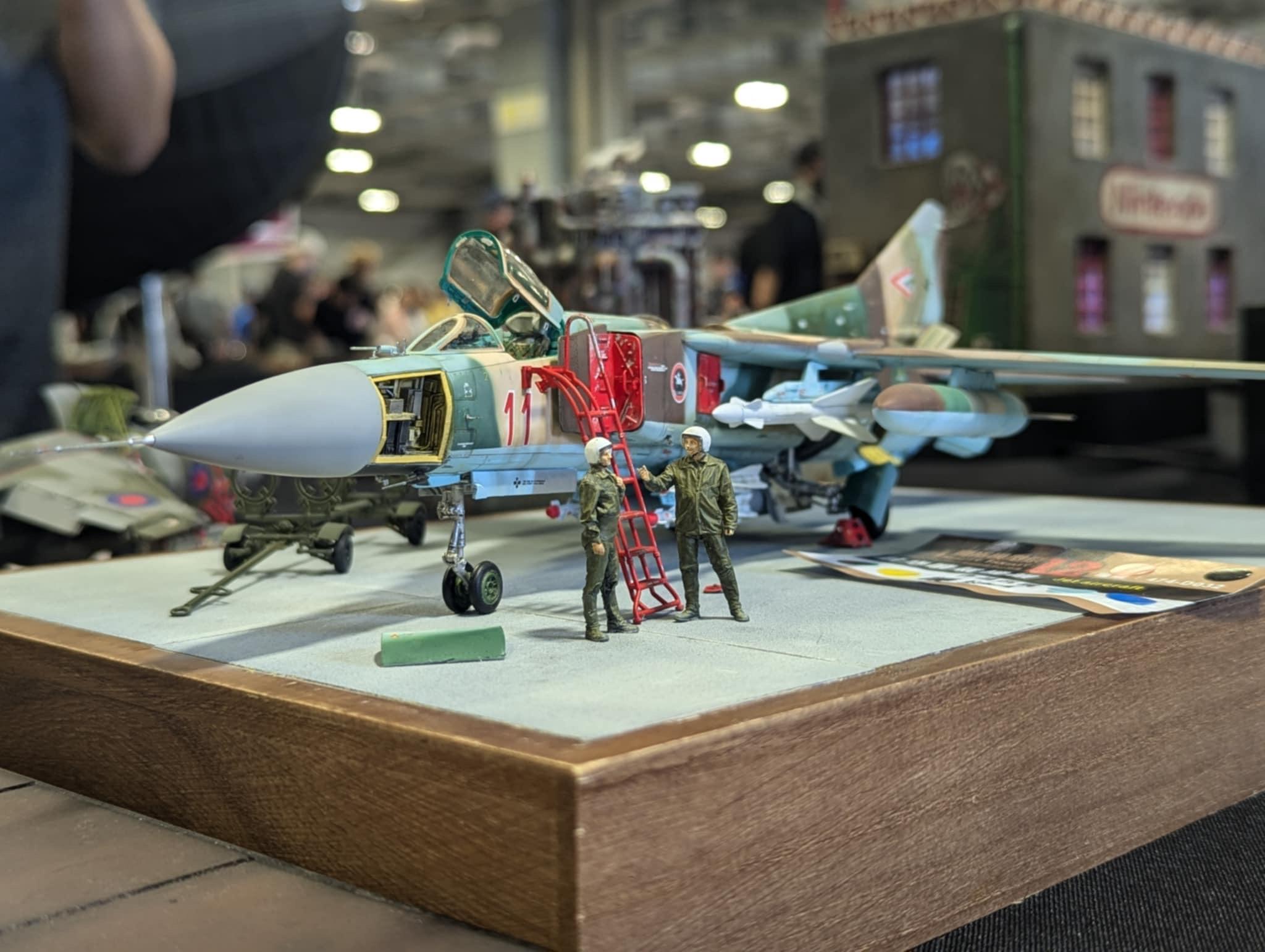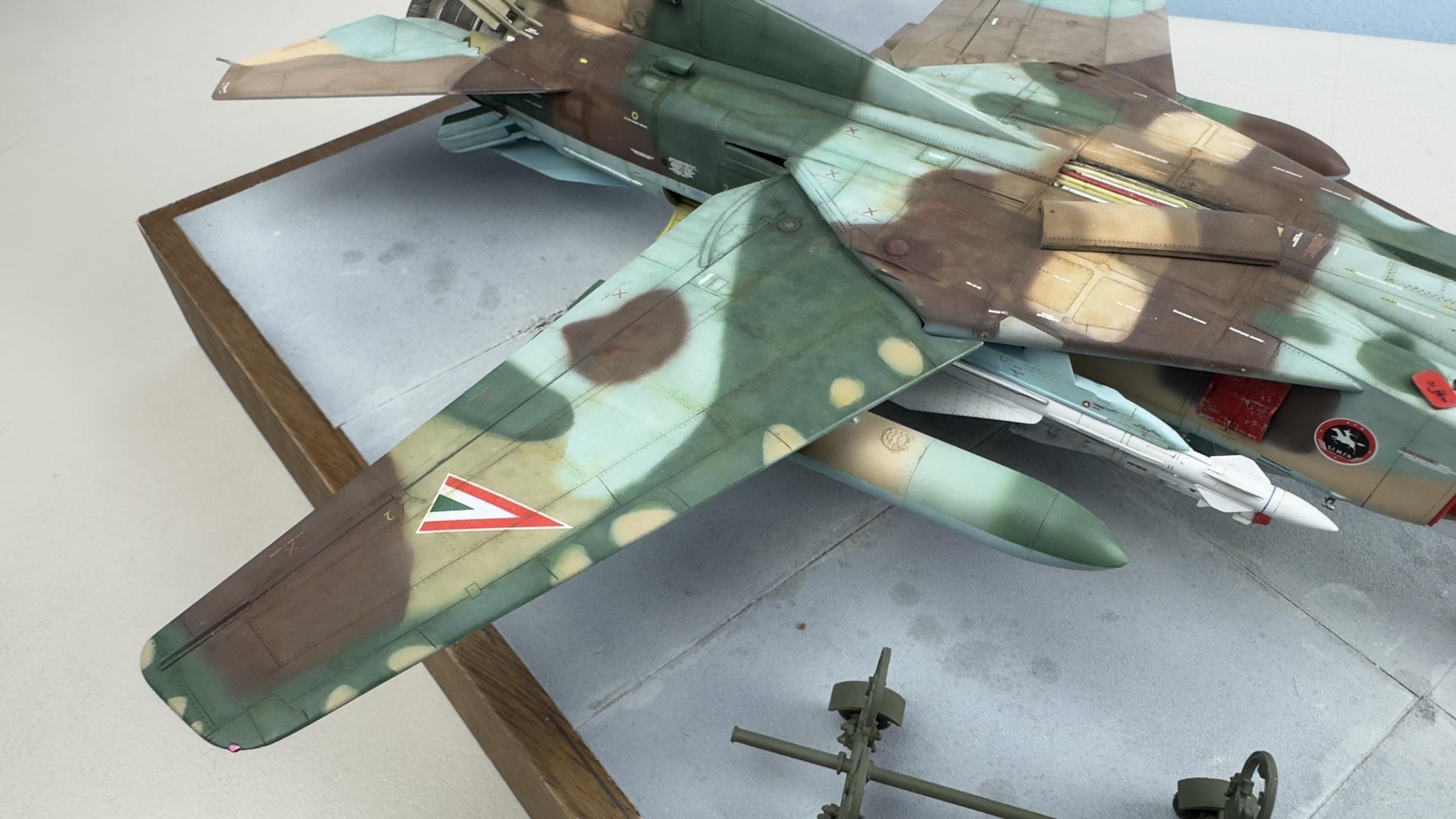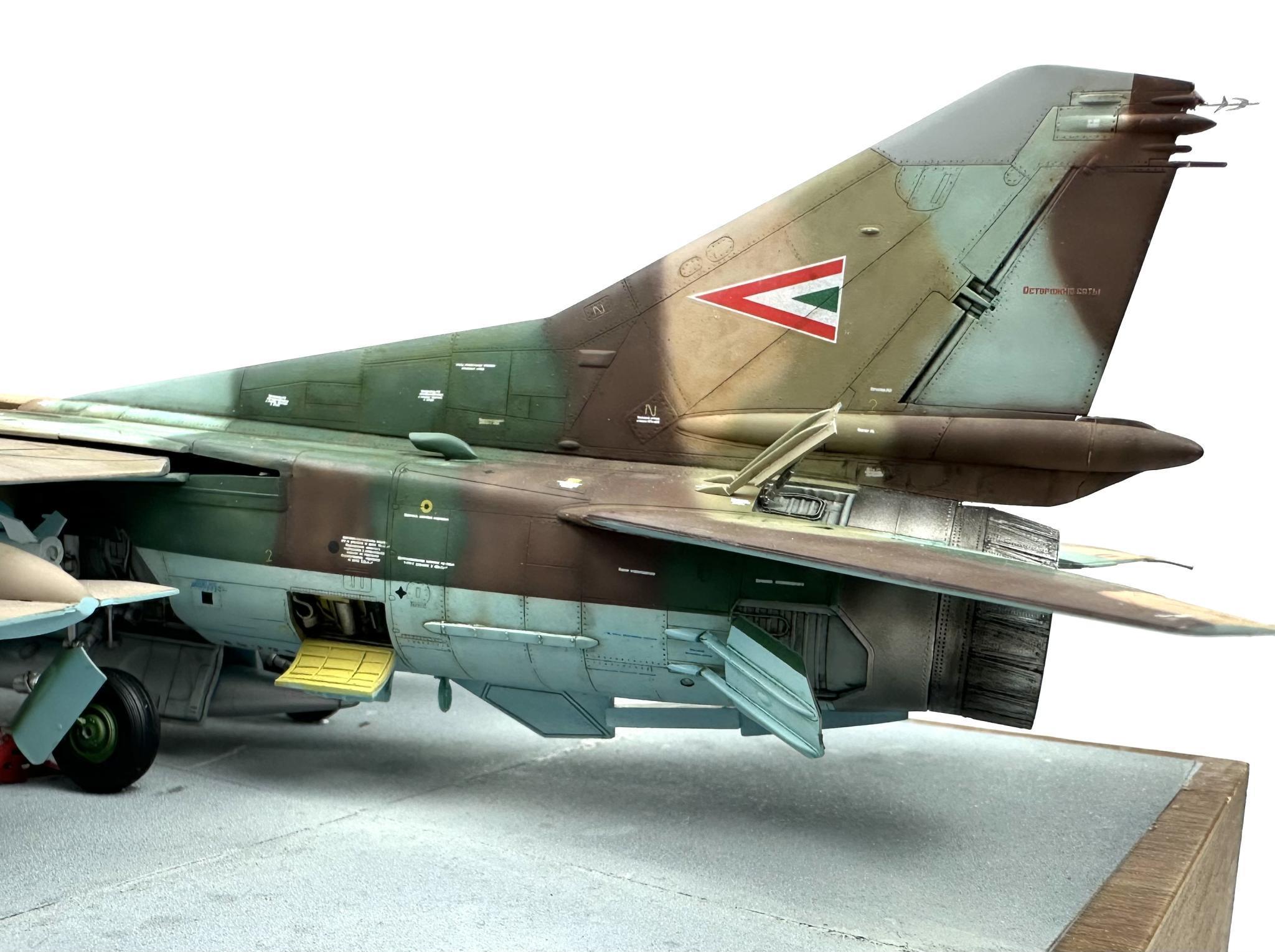Mikoyan-Gurevich MiG-23MF Flogger
1:48, Trumpeter
Pintér György - Múzeumi krimik
The model I assembled this time is the Trumpeter 1/48 MiG-23. Generally speaking, Trumpeter's aircraft models perform excellently in terms of assembly quality and fit, especially when compared to Some Eastern European brands or Italeri. Their structural design is simpler, and when it comes to decals, Trumpeter's own decals have great adhesion and don't require replacements. However, this brand often has minor inaccuracies in the fine details, so I used a lot of aftermarket sets to replace parts like the nose, intake, exhaust, pitot tube, wheels, and missiles to bring the model closer to the real aircraft. For the nose, I used a Metallic Details set to improve its shape.
The Hungarian Air Force introduced the MiG-23 in 1979. As a heavy Soviet-designed fighter, the MiG-23 features variable-sweep wing technology, which allows the wings to adjust based on different flight speeds. The Hungarian Air Force primarily used the MiG-23MF version, which had optimized radar and weapon load capabilities. The MiG-23 gradually retired in the mid-1990s.
The MiG-23 was the first Soviet-designed fighter to adopt the variable-sweep wing technology. This technology allows the wings to manually adjust their angle depending on the flight conditions. During takeoff and landing, the wings extend to provide sufficient lift, while at high speeds, the wings retract and sweep backward to reduce drag and improve flight efficiency. This technology not only enhances flight performance but also allows the aircraft to perform better in a variety of combat environments.
The Hungarian Air Force applied a unique five-color camouflage scheme to the MiG-23. This scheme usually has a gray-green base color, accented with dark green, light brown, sand, and khaki. The combination of these five colors helps to break up the aircraft's outline and improve its concealment in forest, urban, and semi-open terrain. It also gives the Hungarian MiG-23 a distinctive and striking visual effect.
Compared to traditional Soviet camouflage, the Hungarian five-color scheme differs in several ways:
More complex camouflage layers: Soviet schemes often use one to three colors, while Hungary's five-color camouflage has a more intricate combination, creating a richer and more refined overall effect.
Broader regional adaptability: While Soviet schemes are designed for specific environments (e.g., deep green and blue-gray for northern forests and winter conditions), Hungary's five-color camouflage works well in forests, grasslands, and urban environments, offering greater versatility.
Higher visual recognition: The multiple colors used in Hungary's camouflage provide both excellent concealment and increased recognition for friendly forces, reducing the risk of friendly fire.
"Red 11" is a well-known MiG-23 from the 47th Tactical Fighter Squadron (47. Harcászati Repülőezred) of the Hungarian Air Force. This aircraft participated in many military exercises and later became a museum piece after its retirement. There has been some debate about the exact camouflage pattern of this aircraft, with some sources claiming it uses the standard five-color scheme, while others suggest it actually uses six colors, with an additional brown or different shades of sand.
The aircraft likely underwent several refurbishments during its service, and its paint scheme may have changed over time due to maintenance and repainting. According to Hungarian aviation history enthusiasts, some photos show variations in the camouflage colors, likely due to sun exposure and paint aging, creating visual differences. For model builders, choosing the "Red 11" camouflage requires referencing photos from different periods to select the most accurate color scheme.
The MiG-23 is equipped with a powerful armament system, including:
Landing Gear Modification
The design of the landing gear is quite complex. To replicate the real aircraft's retracting gear, the parts are divided into multiple pieces, with some remaining movable before the vertical strut is fixed. After replacing the original landing gear with metal gear and resin wheel bays, I had to use instant glue to simultaneously fix up to five connection points, making adjustments much more difficult. If the original parts were used without modification, the assembly process would have been much simpler.
Intake and Nose Correction
The MiG-23's intake design is quite complicated, and the original kit's intake detail is somewhat lacking, with the injected parts being too thick. To improve this, I added a resin set and Eduard etched brass intake parts, as well as F.O.D (Foreign Object Debris) cover to increase the richness of the model. Additionally, the nose shape was not accurate, so I used the Metallic Details set to correct its outline and make it closer to the real aircraft.
Wing and Tailpipe Adjustments
The MiG-23 has a variable-sweep wing design, but the kit's wing mechanism is somewhat a little bit loose, so I reinforced the pivot joint to make the wings more stable in various positions. Furthermore, when on the ground, the exhaust angel should be going oblique below, but the original kit couldn't replicate this accurately, so I used a resin set to correct it and added burn marks to enhance the realism of the exhaust.
Nose Weight
One notable challenge in the assembly was the need for additional weight in the nose section. To prevent the model from becoming tail-heavy and ensuring it sits properly on its landing gear, I had to add a significant amount of lead weights inside the nose. This was necessary due to the model's design, where the rearward center of gravity required compensation to avoid instability. It took careful planning to position the weights securely without affecting the overall assembly or the appearance of the model.
Although the Trumpeter 1/48 MiG-23 has some imperfections in its details and required a lot of aftermarket parts and modifications to achieve the desired results, I'm still very satisfied with the finished model. I would like to thank Ste for providing a lot of valuable photos and data that allowed me to research the aircraft's history and details more deeply. If I get another chance, I would still choose to build this model and look forward to further improving my techniques and the overall quality in future builds.
Hungarian MiG-23 Overview
The Hungarian Air Force introduced the MiG-23 in 1979. As a heavy Soviet-designed fighter, the MiG-23 features variable-sweep wing technology, which allows the wings to adjust based on different flight speeds. The Hungarian Air Force primarily used the MiG-23MF version, which had optimized radar and weapon load capabilities. The MiG-23 gradually retired in the mid-1990s.
MiG-23's Variable-Sweep Wing Technology
The MiG-23 was the first Soviet-designed fighter to adopt the variable-sweep wing technology. This technology allows the wings to manually adjust their angle depending on the flight conditions. During takeoff and landing, the wings extend to provide sufficient lift, while at high speeds, the wings retract and sweep backward to reduce drag and improve flight efficiency. This technology not only enhances flight performance but also allows the aircraft to perform better in a variety of combat environments.
Hungarian Air Force Five-Color Camouflage
The Hungarian Air Force applied a unique five-color camouflage scheme to the MiG-23. This scheme usually has a gray-green base color, accented with dark green, light brown, sand, and khaki. The combination of these five colors helps to break up the aircraft's outline and improve its concealment in forest, urban, and semi-open terrain. It also gives the Hungarian MiG-23 a distinctive and striking visual effect.
Compared to traditional Soviet camouflage, the Hungarian five-color scheme differs in several ways:
More complex camouflage layers: Soviet schemes often use one to three colors, while Hungary's five-color camouflage has a more intricate combination, creating a richer and more refined overall effect.
Broader regional adaptability: While Soviet schemes are designed for specific environments (e.g., deep green and blue-gray for northern forests and winter conditions), Hungary's five-color camouflage works well in forests, grasslands, and urban environments, offering greater versatility.
Higher visual recognition: The multiple colors used in Hungary's camouflage provide both excellent concealment and increased recognition for friendly forces, reducing the risk of friendly fire.
"Red 11" MiG-23 Camouflage and History
"Red 11" is a well-known MiG-23 from the 47th Tactical Fighter Squadron (47. Harcászati Repülőezred) of the Hungarian Air Force. This aircraft participated in many military exercises and later became a museum piece after its retirement. There has been some debate about the exact camouflage pattern of this aircraft, with some sources claiming it uses the standard five-color scheme, while others suggest it actually uses six colors, with an additional brown or different shades of sand.
The aircraft likely underwent several refurbishments during its service, and its paint scheme may have changed over time due to maintenance and repainting. According to Hungarian aviation history enthusiasts, some photos show variations in the camouflage colors, likely due to sun exposure and paint aging, creating visual differences. For model builders, choosing the "Red 11" camouflage requires referencing photos from different periods to select the most accurate color scheme.
Armament
The MiG-23 is equipped with a powerful armament system, including:
- GSh-23L twin-barrel 23mm autocannon (mounted on the underside of the fuselage with a 200-round magazine)
- R-23 (AA-7 Apex) radar-guided air-to-air missile
- R-60 (AA-8 Aphid) short-range infrared-guided air-to-air missile
- S-24 unguided rockets
- FAB-250 and FAB-500 bombs
- Kh-23 (AS-7 Kerry) air-to-ground missile (depending on mission requirements)
Building Process and Challenges
Landing Gear Modification
The design of the landing gear is quite complex. To replicate the real aircraft's retracting gear, the parts are divided into multiple pieces, with some remaining movable before the vertical strut is fixed. After replacing the original landing gear with metal gear and resin wheel bays, I had to use instant glue to simultaneously fix up to five connection points, making adjustments much more difficult. If the original parts were used without modification, the assembly process would have been much simpler.
Intake and Nose Correction
The MiG-23's intake design is quite complicated, and the original kit's intake detail is somewhat lacking, with the injected parts being too thick. To improve this, I added a resin set and Eduard etched brass intake parts, as well as F.O.D (Foreign Object Debris) cover to increase the richness of the model. Additionally, the nose shape was not accurate, so I used the Metallic Details set to correct its outline and make it closer to the real aircraft.
Wing and Tailpipe Adjustments
The MiG-23 has a variable-sweep wing design, but the kit's wing mechanism is somewhat a little bit loose, so I reinforced the pivot joint to make the wings more stable in various positions. Furthermore, when on the ground, the exhaust angel should be going oblique below, but the original kit couldn't replicate this accurately, so I used a resin set to correct it and added burn marks to enhance the realism of the exhaust.
Nose Weight
One notable challenge in the assembly was the need for additional weight in the nose section. To prevent the model from becoming tail-heavy and ensuring it sits properly on its landing gear, I had to add a significant amount of lead weights inside the nose. This was necessary due to the model's design, where the rearward center of gravity required compensation to avoid instability. It took careful planning to position the weights securely without affecting the overall assembly or the appearance of the model.
Final Thoughts
Although the Trumpeter 1/48 MiG-23 has some imperfections in its details and required a lot of aftermarket parts and modifications to achieve the desired results, I'm still very satisfied with the finished model. I would like to thank Ste for providing a lot of valuable photos and data that allowed me to research the aircraft's history and details more deeply. If I get another chance, I would still choose to build this model and look forward to further improving my techniques and the overall quality in future builds.

|
|
|

|
|
|

|
|
|

|
|
|

|
|
|

|
|
The left wing has a different scheme
|

|
|
|

|
|
|

|
|
|

|
|
|

|
|
|

|
|
|

|
|
|

|
|
|

|
|
|

|
|
|

|
|
|

|
|
|

|
|
|

|
|
|

|
|
|

|
|
|

|
|
|

|
|
|

|
|
|

|
|
|

|
|
Red 11 won 3rd place on the Taiwan Model Show in 2024
|

|
|
Master sergeant Gyula Molnár next to Red 11
|
2025.03.13.


